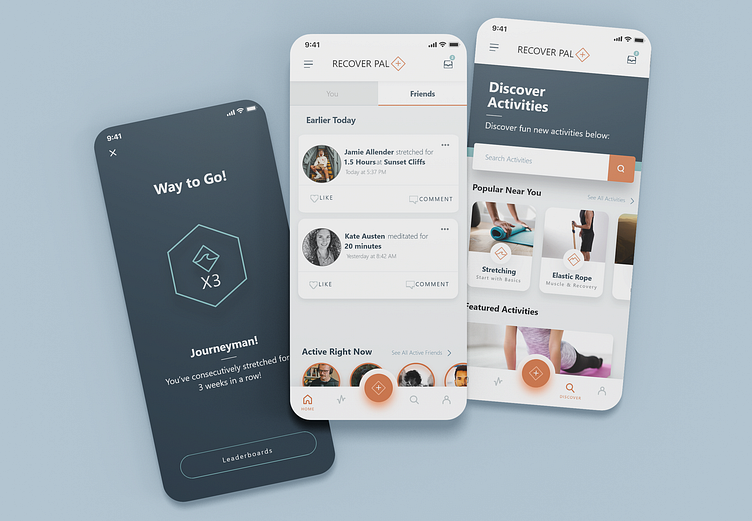Social Fitness App Design
Overview
Recover Pal is an app designed to create a thriving social fitness community, empowering users to connect, engage, and achieve their fitness goals together. This case study explores the process of designing and developing Recover Pal, focusing on fostering a sense of community, promoting user engagement, and providing a visually motivating interface.
Key Findings:
Fitness enthusiasts desire a social fitness app that offers a supportive community, workout sharing features, and goal tracking capabilities.
Visual appeal and motivational elements play a significant role in encouraging users to stay engaged and committed to their fitness routines.
Gamification and challenges can enhance user participation and foster a sense of healthy competition.
Defining the Target Audience
The target audience for Recover Pal includes fitness enthusiasts of all levels, from beginners to seasoned athletes, who are passionate about fitness and seek social support and motivation.
User Personas
Two primary user personas were created to represent the target audience:
Ryan - The Fitness Newbie
Age: 25
Occupation: Marketing Analyst
Personality: Eager, determined, and looking to start a fitness journey.
Needs: Seeks a social fitness app with workout ideas, supportive community, and tracking features to monitor progress.
Concerns: Worried about comparing himself to more experienced fitness enthusiasts.
Emily - The Fitness Enthusiast
Age: 30
Occupation: Personal Trainer
Personality: Encouraging, competitive, and passionate about helping others reach their fitness goals.
Needs: Requires an app that allows her to share workout routines, create challenges, and inspire others to stay motivated.
Concerns: Concerned about maintaining user engagement and providing a positive environment for all users.
Design Goals
The design goals are:
Community Building: Create a social fitness app that fosters a sense of community, allowing users to connect, follow, and support each other.
Engaging Visuals: Implement motivating visuals, including achievements, progress badges, and visual workout tracking to inspire users.
Workout Sharing and Challenges: Offer features for users to share their workouts, create fitness challenges, and celebrate achievements together.
Personalization: Enable users to personalize their profiles, fitness goals, and preferences for tailored fitness experiences.
Tracking and Progress: Provide comprehensive tracking features to monitor fitness progress, including exercise history and performance analytics.
Information Architecture
The app's information architecture was structured as follows:
Home: Displaying a personalized feed with workout updates, challenges, and community posts.
Workouts: Allowing users to discover and participate in a wide range of workout routines and fitness challenges.
Progress Tracking: Providing users with exercise history, statistics, and personal records.
Community: Enabling users to connect with others, follow friends, and join fitness groups.
Profile: Allowing users to manage their profiles, achievements, and fitness preferences.
Visual Design
The visual design of Recover Pal aimed to create a vibrant and inspiring interface, with attention to colours, typography, and iconography. The design elements were aligned with the app's brand identity, representing motivation, health, and vitality.
Conclusion
The app's focus on community building, engaging visuals, workout sharing, and personalization ensures an empowering and supportive social fitness experience. By promoting fitness achievements and fostering a positive environment, Recover Pal tries to be a motivating and inspiring social fitness app, empowering users to achieve their fitness goals together.

